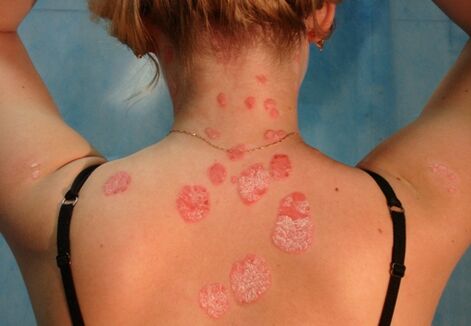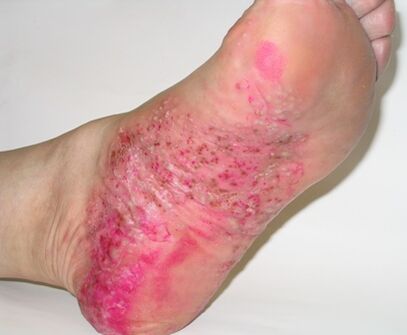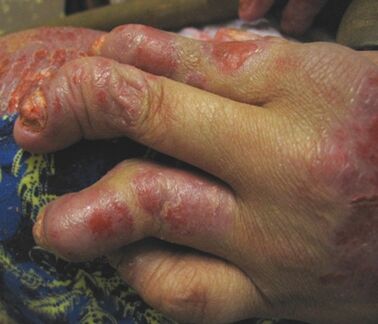According to the WHO, 2–4% of the world's population currently suffer from psoriasis. This disease affects patients of all ages, but most commonly young people (15-25 years old). Unfortunately, today medicine is unable to completely cure psoriasis, but timely professional treatment significantly improves the quality of life. Therefore, when recognizing the first symptoms, it is better to consult a doctor immediately.
psoriasis- This is a dermatosis that manifests itself in the form of scaly papules on the skin. Its peculiarity is that, in addition to the skin, it can also attack joints and nail plates. In the pathogenesis of psoriasis, hereditary factors are clearly traced, and other irritants are only secondary causes of their occurrence.
During an exacerbation of the disease, the natural processes of formation are disrupted - keratinocytes (cells that mainly make up the human skin). There are also pronounced biochemical changes in the skin. In addition, doctors have recently been able to determine that the function of the nervous system also deviates from the norm in the acute phase of the disease. In general, the main reason for psoriasis to appear is the presence of dysfunctional immune system.
Prevalence of psoriasis
Psoriasis is common. At the moment the incidence statistics look something like this:
- China - 0. 3%;
- USA - 1%;
- Denmark - 1-2, 3%;
- Northern Europe - 3%;
- Germany - 1-1, 3%.
It is strange that the indigenous population of South America is not affected by the disease. At least not a single such case has been reported so far. If you look at the overall situation, the proportion of psoriasis is around 6-8% of all skin diseases.
As mentioned earlier, psoriasis manifests itself at any age, but most often young people (up to 25 years old) still suffer, and it occurs with the same frequency in both men and women.
Epidemiological situation
Due to the causes of its occurrence, psoriasis is a non-infectious disease with a pronounced genetic predisposition. The people most at risk of getting sick are those whose relatives also have the disease (in this case only the next of kin are meant). European researchers have established with certainty that a parent's disease has a 14-25% chance of being passed on to their child. If both parents are sick, this probability is already 41-60%.
Depending on the nature of the development of the disease, psoriasis is divided into two groups:
- early;
- late.
This is evidence that there are two main types of psoriasis (like diabetes mellitus). The first occurs at an early age in humans (average 16-22 years), is strictly hereditary, and is directly related to the HLA phenotype (HLA-Cw6). The disease process is often severe and over time the disease only progresses.
The causes of psoriasis type II are rather random, so this disease occurs sporadically. It is most common in the elderly (around 60 years old). It's generally fairly straightforward, but in some cases it can be made worse by damage to the joints and nails.
Factors provoking the appearance of psoriasis
Although psoriasis tends to be inherited, it is generally multifactorial. Anything can trigger this fatal immune system malfunction. Provoking factors are thus divided into external and internal (or, in scientific terms, exogenous and endogenous).
Exogenous factors

In turn, they are divided into physical and chemical. The former include the usual mechanical damage to the skin, such as household injuries, burns, abrasions, scars, tattoos, scratches, insect and pet bites. Cases of psoriasis at the injection sites were also recorded. X-rays and ultraviolet radiation also play an important role. The disease occurs in about 5% of all cases in summer, 40% of which are due to sunburn.
Chemical factors are the toxic effects of harmful chemicals or other irritants on the skin. In addition, psoriasis is also caused by other skin diseases, such as:
- Dermatoses;
- Fungal infections;
- contagious impetigo;
- Acne;
- Dyshidrosis;
- Lichen;
- Herpes zoster;
- gangrenous pyoderma;
- allergic dermatitis of various types.
Cases of illness are known after performing elementary diagnostic skin tests to find out the body's reaction to cosmetics, hygiene products, formalin, chromium, nickel and other chemicals.
Endogenous factors
Internal causes of psoriasis can be infectious diseases. The latest research in the area suggests that strep infections and HIV are most likely to be responsible. In addition, the symptoms often do not appear during the illness itself, but also after the usual vaccination. In these cases, psoriasis is often difficult to treat.
Lithium supplements, beta blockers, nonsteroidal anti-inflammatory drugs, and ACE inhibitors are used to induce remission. Corticosteroids are contraindicated in this case.
Pregnancy and childbirth
Significant changes in hormone levels caused by pregnancy can also become a provoking factor. A similar pattern is also seen during puberty. It is also curious that women who already have psoriasis can experience improvement in their condition during pregnancy (40%). Worsening is much less common (only in 14% of cases). True, after childbirth the condition worsens in most patients (54% of cases)
Diet and nutrition
These factors often have no noticeable influence on the course of the disease. It is only known with certainty that alcohol and cigarette abuse significantly increase the likelihood of developing psoriasis and make it worse.
Hypocalcemia and hypokalemia
These factors can lead to the occurrence of generalized pustular psoriasis. In this case, the chances of a favorable outcome are very slim.

Pustular psoriasis.
Psychogenic factors
Their role is considered quite controversial today. Some researchers claim that the presence of traumatic psychogenic factors provokes psoriasis in 60% of all cases. However, it is only known for certain that they can only aggravate the course of the disease and reduce the effectiveness of the therapy.
classification
At the moment, several different types of psoriasis have been identified. They differ significantly in the clinical picture and in the degree of effect on the body. To get an idea of what is at stake, it is better to look at the World Wide Web and carefully study the photos of psoriasis of various etiologies and familiarize yourself with the description.
Vulgar psoriasis
Vulgar or common psoriasis occurs in most of the cases. This disease manifests itself as an abundant rash of small, bright red papules (from the match head to the pea). After emergence, they grow quickly and silvery-white scales appear on their surface. In the future, papules will turn into plaques that merge into one large lesion. Very often they have clear boundaries that separate them from healthy skin.
If you try to comb or remove the papules, the flaking will increase first. This phenomenon is known as the "stearin stain symptom" and when all of the scales have been removed a shiny, smooth surface called the "terminal film symptom" can be found. If you keep scratching, capillaries will be broken and blood droplets will be released. This symptom is known as "blood thaw".
The development of psoriasis is divided into three main periods:
- progressive (acute);
- stationary;
- Termination Period.
The success of the treatment depends above all on how correctly the therapy methods are selected, as their effectiveness varies greatly depending on the period.

Progressive period. A feature of this stage is the severe appearance of a certain rash. During the period of exacerbation, certain parts of the patient's body are covered with small papules that actively peel off. The peeling in this case is strictly localized and does not affect healthy skin. Acute psoriasis is easy to recognize by the characteristic red or pink border that borders the papules.
The most characteristic symptoms at this stage are itching and the presence of the so-called Koebner symptom. The latter is manifested in the fact that at the site of a skin injury (small burns, scratches, injections, scratches, etc. ) psoriasis papules appear. This phenomenon occurs on average two weeks after the injury itself and occurs in 38-76% of all patients.
It is also extremely strange that the opposite effect is also observed (much less often). Scientists believe that it is caused by the presence in the blood serum of some patients of special factors that inhibit Koebner syndrome.
Stationary time. On average, the formation of new papules stops 2-3 months after the first rashes appear. The growth of plaques also stops. At this point, their entire surface is already covered with scales. This period can last months or even years. However, the latter is relatively rare.
Term of Dissolution. This period is also known as the regressive period because a gradual decrease in plaque is observed during this time. At first they stop peeling, and then gradually smooth out until they completely disappear. If the disease is mild, this phenomenon occurs spontaneously. The treatment only speeds up the onset. Often the place where the plaques were located stands out due to depigmentation or, what is less common, due to hyperpigmentation against the background of healthy skin areas. In psoriasis vulgaris, rashes can occur almost anywhere and are usually located symmetrically (stretch surfaces of the elbows and knees). Can also appear on the head, sacrum, hands, palms, soles of the feet, groin, and armpits. In addition, in many cases the nail plates are also affected (appearance of punctiform dimples, loosening, thickening). These symptoms are very similar to those that occur with a fungal infection, so the final diagnosis is made in a special laboratory test only after a negative reaction to fungal spores. Overall, psoriasis vulgaris has no negative effects on the patient's body and is chronic. Periods of exacerbation occur in autumn or winter, while exacerbations are much less common in summer. The main incentive for active treatment is that, without appropriate therapy, psoriatic plaques can cover the body for years, while adequate treatment improves after a few months.
Psoriatic erythroderma
Psoriatic erythroderma is one of the most uncomfortable forms of this disease. On average, a similar reaction is observed in about 2% of patients, occurring both spontaneously and as a result of an incorrectly selected treatment. Of course, if the drugs used irritate the skin or are exposed to ultraviolet radiation, the risk of psoriatic erythroderma is much higher. Most often, psoriatic erythroderma occurs suddenly during the first stage of psoriasis. It can be combined with arthritis and generalized pustular psoriasis, and exposure to factors such as strep infection or hypocalcemia significantly increases the likelihood of such a complication. Abrupt discontinuation of corticosteroids can also make the condition worse. The appearance of erythroderma completely eliminates the clinical symptoms of psoriasis, which are replaced by diffuse reddening of the skin, severe itching and lamellar peeling.
Pustular psoriasis
Also a severe form of psoriasis. It is characterized by the appearance of abscesses, which often remain the only symptom. Much less often they are combined with the classic symptoms of psoriasis vulgaris. Pustular psoriasis is generalized and localized. The second differs only in that in this case the abscesses are concentrated only in the area of the palms of the hands or the soles of the feet.
Psoriatic arthritis
Psoriatic arthritis is currently classified as an autoimmune disease in its own right. It manifests itself in bone and muscle damage in patients who already suffer from psoriasis or who have a high risk of disease from a family history. Very often psoriatic arthritis is combined with classic psoriasis, as well as psoriatic nail lesions. This disease is diagnosed by the appearance of back pain, accompanied by the following conditions:
- lack of clearly stated reason for appearance;
- the patient's age is over 40;
- unprovoked deep pain in the lower back or buttocks;
- indistinct pain localization;
- relief of pain after exercise;
- Pain or stiffness is felt early in the morning or at night;
- the presence of pain with an excellent general condition of the musculoskeletal system.
Psoriasis of the nail plates
Very often psoriasis vulgaris is accompanied by nail damage. In this case, their pronounced dystrophy, as well as the symptoms characteristic of fungal infections, are observed. It is a common companion to psoriatic arthritis. If you consider that around 4% of the world's population have common psoriasis, then 30-50% of them also have nail psoriasis.
Psoriasis treatment
Unfortunately, at the moment medicine is not yet able to cure psoriasis, since it requires a much deeper knowledge of the peculiarities of the work of the basic mechanisms of the human immune system. Since this type of research progresses rather slowly and the disease itself does not pose a particular threat to life, symptomatic therapy is currently in the foreground. Before starting treatment, the patient must be thoroughly examined, since each organism contains an individual set of factors that influence the course of the disease. Gender, age, occupation, general state of health, type of psoriasis - all of these must be taken into account when prescribing therapeutic therapy. Determining the course of the disease, the individual susceptibility to drugs and the current stage of the disease also play an important role.
General activities
First of all, the doctor needs to determine the mental and physical condition of the patient, assess the general condition of his body and find out how tolerant he is of the disease. The best conditions for effective treatment are good rest, a quiet environment, a change to a less intensive way of working, or a short-term hospital stay. Various methods of psychotherapy (rehabilitation in seaside resorts using cognitive behavioral therapy, etc. ) have also proven to be very effective. It is also very important that the patient knows that the healing process is going as intended, because without a rapid effect around 40% of patients lose confidence in the effectiveness of the therapy and begin to ignore it. It is important not to forget that psoriasis is a chronic disease, so it is necessary to consider the safety of therapy. Many drugs are toxic and can build up in the body and become a time bomb. It can also be addictive, so it is better to save the strongest medications until the really dangerous symptoms appear.
Course of disease and long-term prognosis
The course of psoriasis is often unpredictable. Modern doctors practically failed to do this, so psoriasis remains an unpleasant and uncontrollable disease. It is very individual, so that any attempt to make a prognosis about the course of the disease and the duration of the exacerbation and remission phases is doomed to failure from the outset. Only one thing pleases - despite the difficulty of treatment, it rarely poses a real threat to the patient's life. As for psoriatic arthritis, this disease is much easier than rheumatoid arthritis, and the deterioration in the quality of life of patients compared to the latteris very insignificant. Statistics show that most psoriatic arthritis patients, with proper treatment, can remain functional and lead full lives. If the necessary therapy is absent or the disease progresses with complications, joint deformities can develop with the further development of severe pathologies. However, such complications only occur in a very small number of patients with psoriasis. Most patients can expect a gradual stabilization of the condition and the occurrence of long-term remissions (more than two years). In very rare cases, the disease proceeds mainly in the active phase, but in this case it can be effectively localized. Effective treatment for psoriasis can be obtained in any major city today. And although, as you know, final recovery cannot be achieved, diet, special medications, and procedures will quickly do their job. In addition, you don't need long-term treatment in a hospital. The doctor's job is only to quickly bypass the first two stages of psoriasis and get the person into remission. After that, the patient can only take care of himself, follow the instructions and forget about the disease for a long time.

























